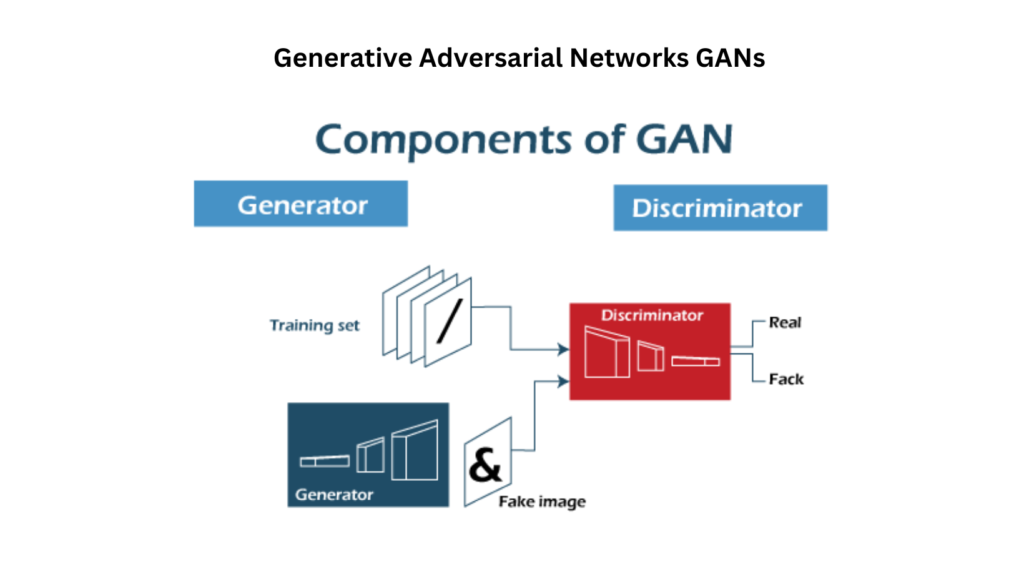
Introduction to Generative Adversarial Networks GANs: The Next Frontier in AI
Generative Adversarial Networks GANs are one of the most fascinating advancements in artificial intelligence. Introduced by Ian Goodfellow in 2014, Generative Adversarial Networks GANs are designed to generate realistic data by pitting two neural networks against each other. Generative Adversarial Networks GANs used in creating everything from hyper-realistic images to predictive healthcare solutions, cementing their role as a cornerstone in AI innovation.
Learn how Generative Adversarial Networks (GANs) are revolutionizing AI. Discover their working, applications, types, and the challenges they overcome in advancing technology.
How Generative Adversarial Networks GANs Work: The Battle of Networks
GANs operate through the interplay of two networks:
- The Generator: This network creates synthetic data, striving to mimic real data.
- The Discriminator: It evaluates the data, identifying whether it is real or generated.
These networks compete in a zero-sum game. The generator tries to outsmart the discriminator, while the discriminator becomes more skilled at spotting fake data. This adversarial training refines the output, making the generated data increasingly realistic.
The Training Process
- The generator creates data from random noise.
- The discriminator evaluates the data as real or fake.
- The generator adjusts its output based on feedback.
- The process repeats until the discriminator can no longer tell real from fake data.
Applications of Generative Adversarial Networks GANs Across Industries
GANs are transforming numerous industries with their innovative capabilities.
1. Image and Video Synthesis
GANs excel in creating realistic images and videos. Applications include:
- Image Upscaling: Enhancing low-resolution images.
- Deepfake Technology: Generating hyper-realistic faces and videos
2. Healthcare Innovation
Generative Adversarial Networks in healthcare, GANs help:
- Generate synthetic medical images to train diagnostic models.
- Model molecular structures for drug discovery.
3. Data Augmentation
GANs generate synthetic datasets, crucial for:
- Balancing skewed datasets.
- Training AI models with limited real-world data.
4. Art and Entertainment
GANs unlock creativity by:
- Generating unique artwork.
- Designing immersive gaming experiences.
Types of GANs: Tailored Solutions
Several types of GANs are designed to address specific challenges:
1. Conditional GANs (cGANs)
These allow control over generated outputs by incorporating additional information like labels.
2. CycleGANs
They enable transformations without paired data, such as converting photos from day to night.
3. StyleGAN
Used for generating photorealistic images, StyleGAN is widely adopted in fields like fashion and digital art.
4. Wasserstein GAN (WGAN)
This type addresses training instability, providing more reliable results.
Challenges in GAN Development
Despite their success, GANs face notable challenges:
- Training Instability: Balancing the generator and discriminator is complex.
- Mode Collapse: The generator may produce limited variations.
- Ethical Concerns: Misuse of GANs, such as in creating deepfakes, raises ethical issues.
- Computational Demands: Training GANs requires high computational power, making them resource-intensive.
- Evaluation Difficulties: Measuring the quality of generated data remains challenging, with metrics like FID and IS having their own limitations.
Evaluation Metrics
Assessing the quality of GAN outputs is challenging. Common metrics include:
- Inception Score (IS): Measures diversity and quality.
- Fréchet Inception Distance (FID): Compares distributions of real and generated data.
Future of GANs: Expanding Horizons
The future of GANs is bright. Advancements in training algorithms and hardware will address current challenges, enabling new applications. From creating realistic simulations to advancing personalized medicine, GANs will continue shaping the future of AI.
Conclusion: The Power and Potential of GANs
Generative Adversarial Networks are revolutionizing AI with their ability to create realistic data. From enhancing creativity to advancing technology, GANs have far-reaching impacts. However, addressing their challenges and ethical concerns is essential to harness their full potential responsibly.
Generative Adversarial Networks (GANs) are transforming AI. Discover how GANs work, their applications, and their role in reshaping industries like healthcare and entertainment.